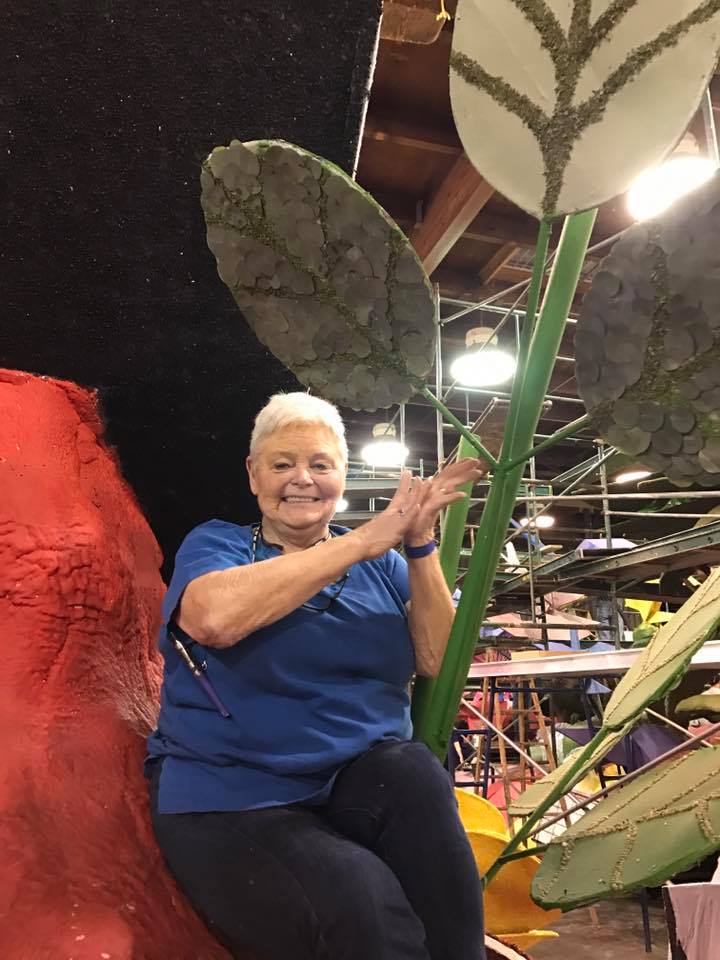Rockton Resident’s Rose Bowl Parade Wish Comes True
By Marianne Mueller, REPORTER
Fifty years ago, Marta Polakowski’s family was living in San Diego, Calif. It was then that a young Marta attended her first Rose Day Parade. “I was awed by the beauty and the grandeur of the floats,” reflects Polakowski. “I later learned that volunteers are needed to do the manual labor, which believe me is required to do a project of this magnitude. I thought, I want to do this someday, and I was 14 at the time.”
“Years came and went. The last 33 of which I have been living in Rockton, where I taught Health at Stephen Mack Middle School from 1996 until my retirement in 2009,” said Polakowski. Polakowski’s dream of working on Rose Bowl floats came true. She spent hours decorating and adding special touches to a variety of colorful and detailed floats seen in the 2017 Rose Bowl Parade. Marta and others flew out to L.A. the day after Christmas. Polakowski volunteered for two different float companies, where she learned from a staff member that it is a year round business. “Some of the companies were already completely booked when we decided to make the trip in mid-October. But, we found some openings. I committed to working four, six hour shifts,” said Polakowski.
Volunteers are supervised by Crew Chiefs, who Polakowski describes as “Wonderful at instructing and checking all of the work done by volunteers! I met people from all across the country!” Polakowski explains the construction process based on information she received from an employee of Phoenix Decorating Co., who she spent the greatest amount of time with. “They take the month of January off and all of the float designers meet in February to learn the theme for next year’s parade. They brainstorm ideas and then choose what décor style their float will use. That way, they insure a good variety of original floats are made, so that everyone is not using the same jungle motif for instance.” After the designers make their drawings, the engineers take it from there and figure out the mechanics. From there the welders begin putting the underlying structure together. When they are done the float is created with white foam and fabric mache. By this time it is nearing the end of summer and the art department comes in and paints the float according to the designer’s specifications. Dry materials can then start to be applied. Volunteers are brought in for the final weeks, starting in mid-December. All of the fresh flowers are added the final week before the parade. The floats are judged the day before the parade.”
What types of prior experience did Marta have before getting to work on floats? “I spent two years working with and learning from designers at Broadway Florist after I retired from teaching. I also worked for two years in the decorating department at Williams Tree Farm. You actually don’t need any experience to volunteer for float decorating. I worked with a doctor, a trial lawyer, a social worker, nurse, an adolescent psychiatric counselor and several other retired teachers.”
Polakowski spent an average of 10 hour days decorating floats with her husband, her son and friend Nick Pfleghaar, joining in her mission at times. Carnation stuffing was used in addition to tomatoes on a Ragu spaghetti float. “We worked for a different company, which had a very different atmosphere. This one was located in a gigantic tent with only four floats, so they were much less packed in and not as close together. It was fun to have the guys along, although I really didn’t work with them. They were also doing tomatoes, but up on scaffolding at the back of the float, while my tomatoes were floor level in the front.” Marta applied eucalyptus leaves and cranberries to the Union Bank-American Heart Association Float.
Polakowski’s talents were spotted on the Trader Joe’s, Western Assets float with a jungle theme (the last float in the parade); plus the Union Bank sponsored and American Heart Association float where flower power beautifully enhanced the beauty in each.
“I got invited back by our crew manager, thanks in part to my friends at Broadway Florist, Brenda West, Barbara Virgili and Tina Kott, who taught me so much about working with flowers, and also my willingness and enthusiasm to do whatever they asked me to do, which involved climbing into tight spaces, balancing on uneven surfaces and at times, reaching farther than I thought was possible with this old body of mine. Yesterday, I worked primarily with red carnations, covering the outside of big bass drums—a very, very sticky job, because the glue they use is really tacky. There were times that my fingers were actually really stuck together,” said Polakowski. ”
Polakowski’s son Tim, who is a Social Worker for Hospice of Northwest Ohio, inspired her to follow her dream. He advised, “Don’t wait to do the things on your ‘Bucket List’, and so here we are. It was everything I thought it might be. I want to thank Tim and his friend Nick for giving me the push I needed!”
Marta watched the five-mile Rose Bowl Parade with her husband, son and close friends on Monday,
Jan. 2. “It was thrilling to see ‘our’ floats in the actual parade!” said Polakowski.
Polakowski is leaving the door open to possibilities of decorating more floats in the future!



